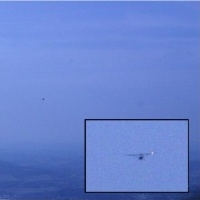
Unmanned Aerial Vehicles (UAVs) today cannot sense and avoid autonomously. However, these aircraft represent a significant mid-air collision hazard to other aircraft operating in the same airspace. In addition, these types of UAS are frequently operated in close proximity to the ground and cultural features (buildings, towers, etc.). Unless they become better than human pilots they will not be allowed to freely operate in commercial air spaces. UAVs do not have the required payload and power to use radar and other active sensors in order to detect other aircraft in a wide field of regard. Cameras with their wide field of regard, low power and weight provide a feasible alternative to active sensors for detecting intruding aircraft within a certain radius. In the U.S. there are approximately 0.5 midair collisions per 1 million flight hours. There have already been several near misses with UAVs and both the military and commercial aviation have called for a system that can automatically avoid mid-air collisions. As stipulated by FAA a human equivalent sense and avoid system must be able to reliably detect and avoid intruding aircraft within a 3 mile radius with a field of regard of 270 x 30 degrees.

